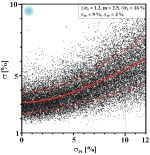EPJ D Highlight - Uniformity: the secret of better fusion ignition
- Details
- Published on 07 October 2013

Fusion is one of the holy grails of energy production. Now, theoretical physicists have used simulations to investigate the uniformity of irradiation at the ignition stage of thermonuclear fusion reaction.
One of the ways to achieve thermonuclear fusion is through a controlled reaction between two light variants of hydrogen, called deuterium and tritium. Mauro Temporal, from the École Normale Supérieure Cachan, in France, and colleagues have made theoretical calculations indicating how best to improve the ignition stage of fusion reaction. Their approach, described in a paper published in EPJ D, involves increasing the uniformity of irradiation using high-power laser beams on the external shell of a spherical capsule containing a mix of deuterium and tritium.
Reaching uniformity of irradiation matters. Indeed, if it can be achieved, it rapidly heats up the capsule and makes it implode, compressing the fuel inside to very high density. This, in turn, induces the compression and heating of a small amount of fuel in a hot spot, which is a sine qua non for reaching the ignition conditions of thermonuclear fusion to produce large energy quantities.
Temporal and colleagues analyse the possibility of using the UK-based Orion facility’s high-power laser beams of to study uniformity. Orion has a few nanosecond-long pulse —5 kiloJoules in energy—which cannot achieve ignition, but can help to test ways to produce uniform irradiation from non-uniformly distributed beams; a technique called Polar Direct Drive.
Specifically, the authors use numerical simulations to analyse the uniformity of the illumination of a spherical target both in the case of circular or elliptical laser intensity profiles. Their work also takes into account other potentially disruptive factors. These include beam-to-beam power imbalance, laser-beam pointing error and target positioning error.
They demonstrate that this approach reduces considerably the non-uniformity of the capsule irradiation—by 50% and 35%, for elliptical and circular intensity profiles respectively.
Polar Direct Drive Illumination Uniformity Provided by the Orion Facility, M. Temporal, B. Canaud, W.J. Garbett, F. Philippe, and R. Ramis (2013), European Physical Journal D, DOI 10.1140/epjd/e2013-40362-4




